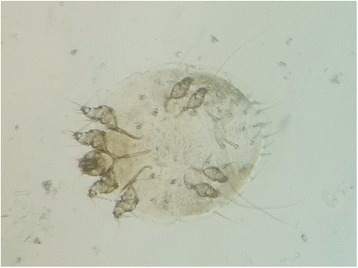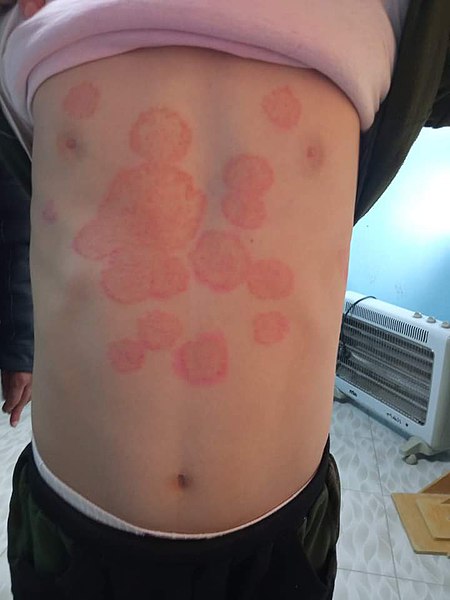Playlist
Show Playlist
Hide Playlist
Scabies, Head Lice (Pediculosis Capitis) and Tinea Corporis (Ringworm) in Children
-
Slides ScabiesLiceandTinea Pediatrics.pdf
-
Download Lecture Overview
00:00 In this lecture, we're going to talk about non-bacterial infestations of the skin that are common in the United States. In particular, we'll discuss scabies, lice and tinea. So, scabies first. Scabies is an infestation with the mite. This mite can be seen microscopically here. It's an allergic reaction to the eggs and the feces of the female mite. This mite burrows down into the epidermis along the stratum corneum. Generally, what this presents us as small, red papulovesicles or dermatic lesions. They generally develop severe itching, generally about 2 to 6 weeks after being exposed to the organism. It often happens on the palms, the soles, the face, the scalp but it can be on the trunk as well and it's worse in warm climates and also children have more itching at night. Generally what you can see on exam is areas of excoriation due to skin scratching. 01:13 Also, you can see a secondary eczematous or urticarial reaction of the skin. Sometimes patients may develop a secondary bacterial infection so don't miss the scabies if there is a superinfection but what you will see are crusted pustular lesions. What is key is a history of itching and very significant itching and these are very characteristic lesions. You can see a good picture right here. If you look very closely especially between the digits right at the fingers, at the base of the fingers, you may see burrows. These are little linear areas where the mite has burrowed down just crawling along the stratum corneum. If you were to scrape this, you could send that to the lab and then they could look microscopically and see the mite or eggs and feces from the mite. So how do we treat scabies? The good news is we can treat it. 02:16 Generally what we ask patients to do is to cover themselves head to toe with permethrin cream 5% and then apply it to all areas and then leave it on for 8 to 12 hours. So generally we say "put it on before you go to bed and wash it off the next morning." This includes the face and the scalp in babies. Also, we generally provide benzyl benzoate emulsion 25% to the low neck only for 12 hours. This smells though, but it's an irritant action. Another option is malathion lotion 0.5% which is again applied below the neck for 12 hours. Whatever treatment methodology you choose, we need to treat the whole family because this is so infectious, it's very likely everyone else is also infected. In very severe cases where most of the body is covered, or in cases of patients with HIV or other immune deficiency, Ivermectin which is another theraputic option. 03:21 Let's move aside from scabies to another annoying infestation which is lice or pediculosis. This is generally benign but it causes a great amount of anxiety. So pediculosis capitis or head lice is the most common form. We see less genital lice now than we used to because of shaving practices. What's key is these animals require being a little bit off the skin to lay their eggs because the eggs require a slightly cool environment where they can multiply. These patients will present with itching of the scalp and the nape and on exam you will see presence of live lice or nits, which are simply empty egg cases where they have ruptured and now they're crawling through the scalp. You can see this on the hairs and that can confirm the diagnosis but sometimes people mistaken it for dandruff and on the other hand these things can move very quickly. These patients tend to have itchy heads but as you're looking through a patient's hair that little louse can _____ from 1 side very quickly and they can be easy to miss. We're going to treat these patients usually with 0.5% malathion solution. You apply it to the hair overnight and then you wash it off. Keep in mind though is we're seeing more and more resistance to these medications but there is something that's a little bit more expensive but works every time which is a benzyl alcohol shampoo. This you put on and leave on for about 20 minutes. That's very effective for resistant lice because it simply smothers and suffocates the louse. So, we apply this shampoo and then oftentimes people are recommended to remove the lice and nits with fine-tooth combs. We call them lice combs. Here's the thing. That will be on your test but in fact it's not particularly helpful. Generally the removal of the lice does not do much. It might be cosmetically beneficial but it doesn't do anything. What you need to do is kill the lice with the shampoo. Then we're going to bag all bedding and all stuffed animals and all pillows, where these lice may live, for a week. Lice must replicate about every week. They die. 05:49 They have a short life expectancy and they also need to be on the skin and they can't travel very far. The reason why kids get this more than adults is kids at school tend to put their heads together and a little louse can crawl from 1 head to the other. Adults don't get this because when we're working in groups we don't put our heads against each other. So these lice can't go too far. By bagging the bedding and the stuffed animals and the pillows and simply putting in the bag if there are any lice in there they will die. If there are any lice eggs in there they will form a louse and then die. So, you really don't have to worry about washing them or chemicals, just put them in a bag. We're going to then repeat the shampoo treatment on the patient's head 1 week later. What this does is it now kills those remaining lice that were eggs during the previous shampooing and thus resistant, they have now become lice and now they'll be killed by the second shampooing. So, shampoo once, shampoo again a week later, put all their stuff in a bag for a week. Let's switch gears now to tinea corporis or ringworm. This is a fungal invasion and it's a dermatophyte fungi that invades the dead keratinous structures of the skin. Typically, it can appear on the skin, the nails, or on the scalp. You see scaling annular lesions or round lesions with a fairly discrete border. On the scalp, they can cause alopecia and you see areas where the hair isn't growing like you can see on this patient. Sometimes, this is acquired from cats and dogs, often it's acquired from other children. If you are to look histologically, you could do an acid-Schiff stain and you could see red hyphae in the stratum corneum and see that fungus growing but generally we don't do that, we usually do a Wood's light exam on a scraping and you can see bright yellow-green fluorescence of the infected hairs or we send that scraping for a KOH stain and then you can see these fungal hyphae which are classic for tinea. How we treat tinea? It's generally very simple. You can use a topical antifungal such as ketoconazole. If there's involvement of their scalp, we add oral griseofulvin because topical therapy is usually not sufficient or if the oral griseofulvin isn't working we may proceed to oral systemic ketoconazole which we like to avoid because it has a slightly worse side effect profile. Also, if the child got it from their pet, we should treat that pet so the child doesn't get it again. So let's review the things that are important from this talk to remember. Scabies is caused by an allergic reaction to eggs and feces from the mite. In scabies, the burrows are pathognomonic. The presence of live lice or nits on a hair confirms a diagnosis of lice. We treat lice with 0.5 malathion solution or benzyl alcohol shampoo if there is a high resistance in the community. Tinea hyphae can be identified by a KOH skin prep. Those are some key points you can remember. Thanks for your attention.
About the Lecture
The lecture Scabies, Head Lice (Pediculosis Capitis) and Tinea Corporis (Ringworm) in Children by Brian Alverson, MD is from the course Pediatric Dermatology. It contains the following chapters:
- Scabies
- Pediculosis (Lice)
- Tinea Corporis (Ringworm)
Included Quiz Questions
Which of the following is true about head lice?
- They are usually treated with 0.5% malathion or benzyl alcohol shampoo.
- Without combing recurrence is inevitable.
- All bedding and stuffed animals are bagged for 24 hours.
- Repeat shampooing is usually not necessary.
- It is more common in adults than in children.
Which of the following is NOT a feature of scabies?
- It is caused by the male mite.
- Severe pruritus after 2 weeks of exposure.
- Palms and soles are often heavily involved in young children.
- Pruritus is more severe in warm climate.
- Lesions are often papulovesicular.
Which of the following dermatological manifestations is most pathognomonic of scabies?
- Burrows
- Papules on palms and soles
- Widespread papulovesicular lesions
- Pruritus
- Crusted macules
Which of the following is the most appropriate recommendation for the topical treatment of scabies in young children?
- Permethrin to all of skin including scalp and face and washed off after 8 hours
- Permethrin to all of skin from neck down and washed off immediately
- Malathione to all of skin including scalp and face and washed off immediately
- Malathione to hair overnight
- Malathione from neck down and permethrine to scalp and face and washed after 8 hours
Which of the following is NOT recommended for the management of pediculosis?
- Avoiding use of fine tooth combs
- Malathion solution
- Benzyl alcohol shampoo
- Bagging all bedding and pillows for a week
- Repeating pediculocide treatment
Which of the following has no application in the treatment of ringworm skin infection?
- Benzyl benzoate
- Topical antifungal
- Oral antifungal
- Concomitant treatment of any pet dogs
- Concomitant treatment of any pet cats
Customer reviews
5,0 of 5 stars
| 5 Stars |
|
1 |
| 4 Stars |
|
0 |
| 3 Stars |
|
0 |
| 2 Stars |
|
0 |
| 1 Star |
|
0 |
I particularly liked the choice of grouping these 3 diseases in 1 lecture.





